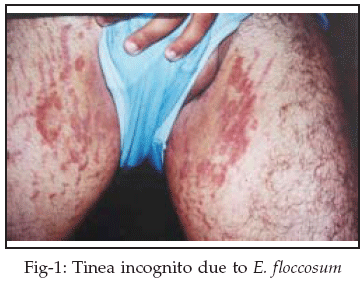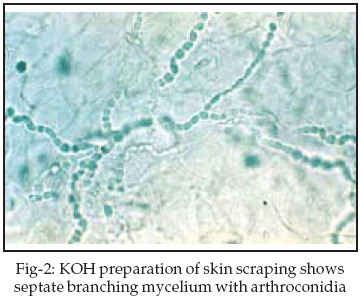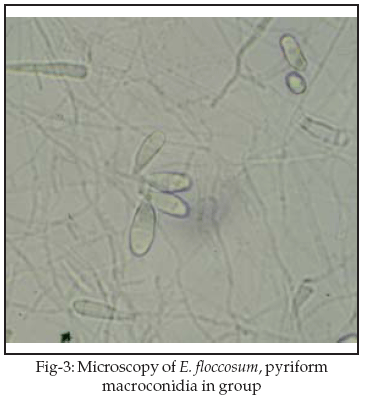|
|
||||
|
Published by : PROFESSIONAL MEDICAL PUBLICATIONS |
||||
|
ISSN 1681-715X |
||||
|
||||
|
- |
||||
|
CASE REPORT |
||||
|
- |
||||
|
Volume 24 |
July - September 2008 |
Number 4 |
||
|
|
||||
|
|
||||
|
|
||||
|
Published by : PROFESSIONAL MEDICAL PUBLICATIONS |
||||
|
ISSN 1681-715X |
||||
|
||||
|
- |
||||
|
CASE REPORT |
||||
|
- |
||||
|
Volume 24 |
July - September 2008 |
Number 4 |
||
|
|
||||
|
|
||||
Tinea incognito due to
epidermophyton floccosum
Ali Zarei Mahmoudabadi1, Zahra Mossavi2
Summary
Tinea incognito is a cutaneous infection with atypical clinical characteristics. Disease is usually caused by administration of steroids. We describe a 25-year-old man who presented with local lesion in groin being treated with corticosteroid. Epidermophyton floccosum, an anthropophilic species, was identified by mycological examinations, direct and culture.
Key words: Tinea incognito, Tinea cruris, E. floccosum.
Pak J Med Sci July - September 2008 Vol. 24 No. 4 618-620
How to cite this article:
Mahmoudabadi AZ, Mossavi Z. Tinea incognito due to epidermophyton floccosum. Pak J Med Sci 2008;24(4):618-20.
1. Ali Zarei Mahmoudabadi,
Department of Medical Mycoparasitology,
2. Zahra Mossavi,
Department of Dermatology,
1,2: School of Medicine,
Jundishapour University of Medical Sciences,
Ahwaz – Iran.
Correspondence
Dr. Ali Zarei Mahmoudabadi,
Department of Medical Mycoparasitology,
School of Medicine,
Jundishapour University of Medical Sciences,
Ahwaz, Iran
Email: zarei40@hotmail.com
* Received for Publication: December 11, 2007
* Accepted: June 21, 2008
Introduction
Tinea incognito is an atypical dermatophytosis that is caused by prolonged use of topical or oral corticosteroids.
1 Disease is usually localized to groin area. Tinea cruris accounted for 7.6% of all dermatophytosis.2 Several reports show that disease more prevalent in Iran.3-5 The highest frequency of tinea cruris is seen in 20-30 years olds suggesting that the peak of the infection is associated with age. We report a patient who had tinea incognito on his groin area caused by E. floccosum after topical corticosteroid application. E. floccosum is an anthropophilic species that is distributed worldwide. It is responsible for most cases of tinea cruris in Iran.3-5Case report
A 25-year-old man presented with 4-6 weeks history of scaling and pruritic lesion involving the groin. The patient had been misdiagnosed as psoriasis and treated with topical corticosteroid for several weeks. With this treatment the lesion initially improved, but later they persisted. Physical examination revealed erythematous scaling lesion with purple stretch marks (Fig-1).

Skin scrapings were collected using sterile scalpel. Direct examination from skin scrapings revealed septate branching mycelium with many arthroconidia (Fig-2).

Collected skin scrapings were cultured on Mycobiotic agar (Difco, East Molesey, UK) slant tubes and incubated at 25-30
oC for 3 weeks, aerobically. The colonies of E. floccosum were characterised by slow growing, gently folding, fuzzy to suede like in texture and khaki in colour. E. floccosum was confirmed in cultures based on the macroscopic and microscopic features. The 2-4 celled pyriform macroconidia were the most important features of E. floccosum (Fig-3). Macroconidia were abundant and arranged like bunches of bananas. Microconidia were absent. In the present study patient was successfully treated with topical clotrimazole (1% cream) three times daily for 3-4 weeks.

Discussion
The typical clinical features of tinea cruris are presenting erythematous scaling lesions with a raise margin. Disease is usually bilateral. The application of topical steroids may modify the clinical picture. The term tinea incognito has been used to describe dermatophyte infections modified by corticosteroid treatment. Tinea incognito typically affects adults and it is seen on the groin,
6 the face1,7-9 and on the dorsal of the hand,10 leg,7,11 arm7,11 and buttock and thigh.11Wacker et al.
12 has also reported one case of tinea incognito at the umbilical region caused by M. canis. Tinea cruris is mainly seen in men and it is seen more frequently in hot and humid environment. E. floccosum was reported as the most prevalent dermatophyte species isolated from tine cruris in Iran.3,5 In others reports T. rubrum was the predominant etiologic agent followed by E. floccosum.2 Gorani et al9 and Sanchez-Castellanos et al1 have reported cases of dermatophytosis of the face due to Microsporum canis and T. mentagrophytes that was modified by a long-term application of topical corticosteroids, respectively.Stretch marks are adverse effect of topical steroids in groins and axillae. In our patient classical features of tinea cruris was modified by application of topical corticosteroid. Sanchez-Castellanos, et al.
1 believe that topical steroids therapy can suppress the local immune response and allow the fungus to grow easily. As a result, the fungal infection may take on a bizarre appearance.Conclusion
The tinea incognito presented in this report was initially misdiagnosed as psoriasis and treated with corticosteroids.
ACKNOWLEDGMENT
We are grateful the Department of Mycoparasitology, Jundishapour University of Medical Sciences for their help and assistance.
References
1. Sanchez-Castellanos ME, Mayorga-Rodriguez JA, Sandoval-Tress C, Hernandez-Torres M. Tinea incognito due to Trichophyton mentagrophytes. Mycoses 2007;50:85-7.
2. Maraki S, Nioti E, Mantadakis E, Tselentis Y. A 7-year survey of dermatophytoses in Crete, Greece. Mycoses 2007;50:481-4.
3. Hedayati MA. Common dermatophytes in Khuzestan province. Sci Med J 1989;10:59-65.
4. Falahati M, Akhlaghi L, Lari AR, Alaghehbandan. R. Epidemiology of dermatophytoses in an area south of Tehran, Iran. Mycopathologia 2003;156:279-87.
5. Sadri MF, Farnaghi F, Danesh-Pazhooh M, Shokoohi A. The frequency of tinea pedis in patients with tinea cruris in Tehran, Iran. Mycoses 2000;43:41-4.
6. Oklota CA, Brodell RT. Uncovering tinea incognito. Topical corticosteroids can mask typical features of ringworm. Postgrad Med 2004;116:65-6.
7. Romano C, Asta F, Massai L Tinea incognito due to Microsporum gypseum in three children. Pediatr Dermatol 2000;17:41-4.
8. Grau Salvat C, Pont Sanjuan V, Sánchez-Carazo JL, Vilata Corell JJ, Aliaga Boniche A. Disseminated inflammatory tinea: An unusual presentation. Rev Iberoam Micol 1998;15:100-2.
9. Gorani A, Schiera A, Oriani A. Case Report. Rosacea-like Tinea incognito Mycoses 2002;45:135–7.
10. Jacobs JA, Kolbach DN, Vermeulen AH, Smeets MH, Neuman HA. Tinea incognito due to Trichophyton rubrum after local steroid therapy. Clin Infect Dis 2001;33:E142-4.
11. Romano C, Maritati E, Gianni C Tinea incognito in Italy: A 15-year survey. Mycoses 2006;49:383-7.
12. Wacker J, Durani BK, Hartschuh W. Bizarre annular lesion emerging as tinea incognito. Mycoses 2004;47:447-9.
HOME | SEARCH | CURRENT ISSUE | PAST ISSUES
Professional
Medical Publications
Room No. 522, 5th Floor, Panorama Centre
Building No. 2, P.O. Box 8766, Saddar, Karachi - Pakistan.
Phones : 5688791, 5689285 Fax : 5689860
pjms@pjms.com.pk